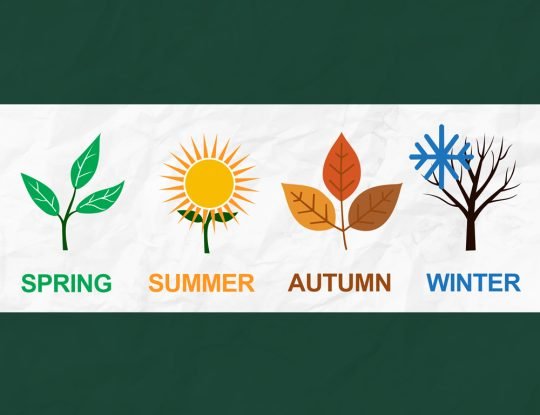By Alex Tisthammer

There is a common misconception that gardeners take the winter off. However, there is plenty you can do throughout the year to keep your yard happy, healthy and looking beautiful! Print this guide out and hang it on your fridge so you have it handy when you’re wondering, “What do I need to do in my yard right now?”
Winter
- Winter watering is critical! Newly planted trees, shrubs and perennials should be watered once to twice a month on a day above 40 degrees. Trees that have been in the ground 1-3 years are still considered newly planted.
- Evaluate and record what seed varieties performed well over the past year and what did not so you can remember what to plant for the next season.
- Prune your trees if needed, especially maples and fruit trees (late February).
Spring
- Early Spring:
- Plan out any new garden beds you want to build in the upcoming year. This gives you plenty of time to consider placement, how it will be watered, what you want to plant, etc.
- Start seed starts for your veggie garden. This can be spread out through the entire spring season, depending on how many days each type of plant takes to germinate and when you can place them outside. I prefer to start my peppers the earliest since they can take a long time to start producing.
- Mid Spring:
- Wait to cut back ornamental grasses until we have a week of 50 degree weather to give the pollinators plenty of time to emerge from their hiding places. (This excludes fescues, as well as sedges and Japanese Forest Grass if they stayed green over the winter).
- Clean up the plant material from your garden beds, trimming out of all of last year’s dead growth on most herbaceous perennials. Not sure what to cut back and what not to? Call the nursery and talk to one of our outside staff.
- Till compost into garden beds to refresh organic matter where needed.
- Plant spring garlic, onions and potatoes once the ground has thawed and can be worked.
- Take the tree wrap off your trees around Easter.
- Sow seeds for cool season crops (lettuce, beets, kale, peas, radishes, etc..) directly in your garden beds
- Cut back lilacs immediately after flowering if you want to shape them or to prune out unwanted branches.
- Late Spring:
- Divide ornamental grasses if they have large brown dead spots in the middle.
- You can divide iris, daylilies and peonies at this time but this may prevent them from blooming, so if you would like to avoid this, divide in autumn.
- Plant cold hardy annuals, keep in mind you may need to cover them if we get a sudden dip in temperatures.
- Fertilize heavy-blooming shrubs like roses and hydrangeas.
- Fertilize established trees (those that have been planted for more than 2 years), but not newly planted ones.
Summer
- Early Summer
- Plant spring bulbs like dahlias, cannas, elephant ears or freesias.
- Plant tender annuals outside.
- Look for signs of life from your perennial hibiscus (early June).
- Cut the scapes off your hardneck garlic once they appear to concentrate energy growing the bulb. You can cook scapes, so don’t toss them in the bin!
- Fertilize tomatoes and peppers.
- Mid Summer
- Pull any bolting lettuce or other leafy veggies.
- Fertilize hydrangeas and roses again to keep them blooming.
- Harvest your fall garlic when about half the leaves have browned.
- Weed weed weed! It’s hard to keep up with but this is when they are starting to really take off and seem to appear overnight!
- Late Summer
- Resow lettuce, radishes, and other cool season crops as the weather cools.
- Plant mums and other fall annuals like ornamental kale, snapdragons and pansies.
- More weeding!
- Harvest potatoes and onions.
Autumn
- Divide peonies, iris and daylilies if needed (and you didn’t in the spring).
- Pick the last of the tomatoes and other frost sensitive veggies before the last frost.
- Once your sprinkler system gets shut off, keep watering on those hot days, we definitely get those in October still!
- Plant fall bulbs like tulips, crocus, daffodils and hyacinths.
- Plant fall garlic and mulch with hay or pine needles.
- Put tree wrap on newly planted trees around Thanksgiving.
- Put rose collars around grafted roses.
- Spread winterizer fertilizer on your lawn.
Originally published on January 31st, 2023. Updated on March 28th, 2024.
